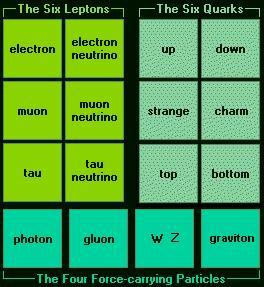Taking a closer look at LHC
The Standard Model of Particle Physics is the best theory that physicists currently have to describe the building blocks of the universe. It is one of the biggest scientific achievements in twentieth-century science.
|
The Standard Model describes the universe using 6 quarks, 6 leptons and a few force-carrying particles. There arefour known forces (or interactions), each mediated by a fundamental particle, known as a carrier particle. Photons, gravitons, and gluons have no mass, whereas weak-force carrier particles (W± and Zº) have mass 80-90 GeV.
Gravity is only included in the Standard Model by tentative hypothesis, but gravitons have never been directly observed.
|
|
|
At very high energies levels and very small scales the other three forces become almost identical, but the convergence is imperfect. Electromagnetic & gravitational forces vary as the inverse square of distance without limit (to infinity). But the strong and weak nuclear forces are short-range rather than inverse-square forces. Short-rangeforces only operate at very short ranges through the exchange of particles. Whereas inverse-square forces have no range-limits. It is the non-zero rest mass of the short-range force-mediating particles which causes them to decay quickly and thereby limits their range. For the strong nuclear force the exchange-particle is the gluon (nuclear "glue"). For the weak nuclear forcethe exchange-particle is W+, W- or Zº. |
 |
|
Particles that are affected by the strong nuclear force are called hadrons, whereas leptons are not affected.Hadrons are formed by quarks, so they are not considered elementals, but leptons have no structureand they are thus truly elementary. There are six types (also so-called flavors) for quarks and leptons. |
|

This is a radically new feature of the strong force, never before encountered, but understandable in terms of the details of the strong forces characteristics.
As mentioned above, quarks usually combine in groups of two and three to form hadrons. However, on rare occasions, they can also combine into particles of four and five quarks, or "tetraquarks" and "pentaquarks". These exotic hadrons were predicted by theorists at the same time as conventional hadrons, about six decades ago, but it is only in the 21st century that they have begun to be observed, by the LHCb and other experiments. (See more...)
Fermion: name for a particle that is a matter constituent, characterized by spin in odd half integer quantum units (1/2,3/2,5/2...). Named for Italian physicist Enrico Fermi. Quarks, leptons and baryons are all fermions.
Fermions, cannot occupy the same quantum state as each other. They obey the Fermi-Dirac statistics and the Pauli exclusion principle. They "resist" being placed close to each other. So, fermions possess "rigidness" and thus sometimes are considered to be "particles of matter".
The Pauli exclusion principle obeyed by fermions is responsible for the stability of the electron shells of atoms (thus for stability of atomic matter). It also is responsible for the complexity of atoms (making it impossible for all atomic electrons to occupy the same energy level), thus making complex chemistry possible. It is also responsible for the pressure within degenerate matter which largely governs the equilibrium state of white dwarfs and neutron stars.
Boson: name for any particle with a spin of an integer number ( 0,1 or 2...) of quantum units of angular momentum. (named for Indian physicist S.N. Bose). The carrier particles of all interactions are bosons. Mesons are also bosons (named for Indian physicist and mathematician Satyendra Nath Bose, a physicist best known for his collaborations in the 1920s with Albert Einstein wich resulted in the invention of Bose-Einstein statistics).
In contrast to fermions, several bosons can occupy the same quantum state. Thus, bosons with the same energy can occupy the same place in space. After the discovery of Hioggs boson, the only boson in the Standard Model that is yet to be discovered experimentally is the graviton.
When a large fraction of the bosons occupy the lowest quantum state a new state of matter is achieved, the Bose–Einstein condensate (BEC).
Superconductivity, the properties of lasers and masers, superfluid helium-4 and others Bose–Einstein condensates are all consequences of statistics of bosons.Principle of Universality of Lepton Flavor
A fundamental axiom of the Standard Model is the universality of the couplings of the different generations of leptons to the electroweak gauge bosons.
The measurement of the ratio of the decay rate of W bosons to electrons and and muons, R(μ/e), constitutes an important test of this axiom. Using 140 fb−1 of proton–proton collisions recorded with the ATLAS detector at a centre-of-mass energy of 13 TeV, ATLAS Collaboration reported a measurement of this quantity from di-leptonic events where the top quarks decay into a W boson and a bottom quark.

The measured value of R(μ/e) is 0.9995 ± 0.0045 is in agreement with the hypothesis of universal lepton couplings as postulated in the Standard Model. This is the only such measurement from the Large Hadron Collider, so far, and obtains twice the precision of previous measurements.
Taken from ATLAS Collaboration (March, 2024): Precise test of lepton flavour universality in W-boson decays into muons and electrons in pp collisions at √s=13 TeV with the ATLAS detector. (58th Rencontres de Moriond 2024)
And other previous very important result comes from the LHCb Collaboration, December 2022, on the Principle of Universality of Lepton Flavor.
The international LHCb collaboration presented on 20 December 2021 new measurements of decays that provide one of the most accurate tests to date of a key property of the Standard Model of particle physics, known as lepton flavour universality.
The weak interaction, as described by the Standard Model (SM), is supposed to act equally for all the leptons. This means that decays involving, e.g., muons or electrons should have equal probabilities (with small corrections due to the different masses of these leptons). An example of such decays are B+→ (K+μ+μ-) and B+→ (K+e+e-), in which a beauty meson decays to a pair of leptons, accompanied by a K meson. Following the reasoning above, if one measures the probability of both decays and then makes the ratio (RK) of these probabilities one would theoretically expect a value very close to 1. Previous studies of these decays have shown significant differences from theoretical predictions, potentially due to the effects of new particles or forces.
The results announced in Dec 2022, which exceed previous comparisons, are in perfect agreement with the Principle of universality of leptonic flavour.
|
AUTHORS Xabier Cid Vidal, PhD in experimental Particle Physics for Santiago University (USC). Research Fellow in experimental Particle Physics at CERN from January 2013 to Decembre 2015. He was until 2022 linked to the Department of Particle Physics of the USC as a "Juan de La Cierva", "Ramon y Cajal" fellow (Spanish Postdoctoral Senior Grants), and Associate Professor. Since 2023 is Senior Lecturer in that Department.(ORCID). Ramon Cid Manzano, until his retirement in 2020 was secondary school Physics Teacher at IES de SAR (Santiago - Spain), and part-time Lecturer (Profesor Asociado) in Faculty of Education at the University of Santiago (Spain). He has a Degree in Physics and a Degree in Chemistry, and he is PhD for Santiago University (USC) (ORCID). |
CERN CERN Experimental Physics Department CERN and the Environment |
LHC |
IMPORTANT NOTICE
For the bibliography used when writing this Section please go to the References Section
© Xabier Cid Vidal & Ramon Cid - rcid@lhc-closer.es | SANTIAGO (SPAIN) |




